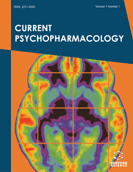Abstract
Background: Bipolar Disorder is a severe psychiatric condition, characterized by depressive and manic mood states. Depressive mood remains a problem for most patients, as this is the predominant mood state, and because the options we have for treating depression remain scarce. Therefore, the quest for new treatment options is ongoing.
Objective: We focus here on one approach in particular, regarding the known influence of factors that disrupt the circadian rhythm in the precipitation of new episodes, as well as the methods available to restore this rhythm, and a new treatment which could theoretically be particularly good for this purpose: Agomelatine. How does it work? What relation does it have to circadian timing? What do we know of its efficacy in treating bipolar depression? And finally, is it an acceptable treatment?
Method: We performed a literature review about the relation of melatonin to circadian cycles, the disruption of circadian rhythms in Bipolar Disorder, chronotherapeutics and finally on agomeltine’s pharmacodynamic profile and use to treat bipolar depression.
Conclusion: Agomelatine shows two very interesting mechanisms of action, a potent overactivation of dopaminergic and noradrenergic neurons in the prefrontal cortex and the amelioration of sleep and more importantly, the amelioration of sleep structure and regulation of circadian rhythms. These may represent an effective option for the depressive phase in bipolar disorder, both as an acute treatment and as a prevention for future relapse.
Keywords: Agomelatine, melatonin, bipolar disorder, chronotherapeutics, circadian circle, rhythm, phase shift.
Graphical Abstract
Current Psychopharmacology
Title:Agomelatine for Bipolar Depression: A Chronotherapeutic Agent?
Volume: 4
Author(s): María Yoldi-Negrete, Claudia Becerra-Palars, Armando Carvajal-Lohr, Alejandra Monserrat Rodríguez-Ramírez and María Alejandra Martín-Manzo
Affiliation:
Keywords: Agomelatine, melatonin, bipolar disorder, chronotherapeutics, circadian circle, rhythm, phase shift.
Abstract: Background: Bipolar Disorder is a severe psychiatric condition, characterized by depressive and manic mood states. Depressive mood remains a problem for most patients, as this is the predominant mood state, and because the options we have for treating depression remain scarce. Therefore, the quest for new treatment options is ongoing.
Objective: We focus here on one approach in particular, regarding the known influence of factors that disrupt the circadian rhythm in the precipitation of new episodes, as well as the methods available to restore this rhythm, and a new treatment which could theoretically be particularly good for this purpose: Agomelatine. How does it work? What relation does it have to circadian timing? What do we know of its efficacy in treating bipolar depression? And finally, is it an acceptable treatment?
Method: We performed a literature review about the relation of melatonin to circadian cycles, the disruption of circadian rhythms in Bipolar Disorder, chronotherapeutics and finally on agomeltine’s pharmacodynamic profile and use to treat bipolar depression.
Conclusion: Agomelatine shows two very interesting mechanisms of action, a potent overactivation of dopaminergic and noradrenergic neurons in the prefrontal cortex and the amelioration of sleep and more importantly, the amelioration of sleep structure and regulation of circadian rhythms. These may represent an effective option for the depressive phase in bipolar disorder, both as an acute treatment and as a prevention for future relapse.
Export Options
About this article
Cite this article as:
Yoldi-Negrete María, Becerra-Palars Claudia, Carvajal-Lohr Armando, Rodríguez-Ramírez Monserrat Alejandra and Martín-Manzo Alejandra María, Agomelatine for Bipolar Depression: A Chronotherapeutic Agent?, Current Psychopharmacology 2015; 4 (2) . https://dx.doi.org/10.2174/2211556004666151008215220
| DOI https://dx.doi.org/10.2174/2211556004666151008215220 |
Print ISSN 2211-5560 |
| Publisher Name Bentham Science Publisher |
Online ISSN 2211-5579 |
 31
31 1
1 1
1 1
1
- Author Guidelines
- Bentham Author Support Services (BASS)
- Graphical Abstracts
- Fabricating and Stating False Information
- Research Misconduct
- Post Publication Discussions and Corrections
- Publishing Ethics and Rectitude
- Increase Visibility of Your Article
- Archiving Policies
- Peer Review Workflow
- Order Your Article Before Print
- Promote Your Article
- Manuscript Transfer Facility
- Editorial Policies
- Allegations from Whistleblowers
- Announcements
Related Articles
-
Imiquimod 5% Cream Use in Dermatology, Side Effects and Recent Patents
Recent Patents on Inflammation & Allergy Drug Discovery Antiplatelet and Anticoagulation Strategies in the Prevention and Treatment of Ischemic Stroke
Current Pharmaceutical Design Migraine and Coronary Artery Disease: An Open Study on the Genetic Polymorphism of the 5, 10 Methylenetetrahydrofolate (MTHFR) and Angiotensin I-Converting Enzyme (ACE) Genes
Central Nervous System Agents in Medicinal Chemistry Antifungal Therapy of Aspergillosis of the Central Nervous System and Aspergillus Endophthalmitis
Current Pharmaceutical Design Voltage-Gated Sodium Channels as Therapeutic Targets for Treatment of Painful Diabetic Neuropathy
Mini-Reviews in Medicinal Chemistry Desmopressin 30 Years in Clinical Use: A Safety Review
Current Drug Safety Synthetic Thioamide, Benzimidazole, Quinolone and Derivatives with Carboxylic Acid and Ester Moieties: A Strategy in the Design of Antituberculosis Agents
Current Medicinal Chemistry The Potentials of Uncariae Ramulus Cum Uncis for the Treatment of Migraine: Targeting CGRP in the Trigeminovascular System
Current Neuropharmacology Effects of Modafinil on Cognitive Performance and Alertness During Sleep Deprivation
Current Pharmaceutical Design Adsorption Based Technologies for Arsenic Removal from Aqueous Environment: A Review
Recent Patents on Engineering Receptor Binding Ligands to Image Infection
Current Pharmaceutical Design Long-Term Safety from the Raltegravir Clinical Development Program
Current HIV Research The Effect of Aerobic Exercise on Quantity and Quality of Sleep Among Elderly People Referring to Health Centers of Lar City, Southern of Iran; A Randomized Controlled Clinical Trial
Current Aging Science Lamotrigine as an Effective Treatment for Behavioral Disorders
Letters in Drug Design & Discovery Oxytocin - A Multifunctional Analgesic for Chronic Deep Tissue Pain
Current Pharmaceutical Design A Review of Recent Patents on the ASICs as a Key Drug Target
Recent Patents on Biotechnology Cyclooxygenase-2 Inhibitors as a Therapeutic Target in Inflammatory Diseases
Current Medicinal Chemistry Identifying Patterns in Signs and Symptoms Preceding the Clinical Diagnosis of Alzheimer’s Disease: Retrospective Medical Record Review Study and a Nested Case-control Design
Current Alzheimer Research New Developments in the Diagnosis and Management of Resistant Hypertension
Current Medicinal Chemistry Disorders of Consciousness and Electrophysiological Treatment Strategies: A Review of the Literature and New Perspectives
Current Pharmaceutical Design


























